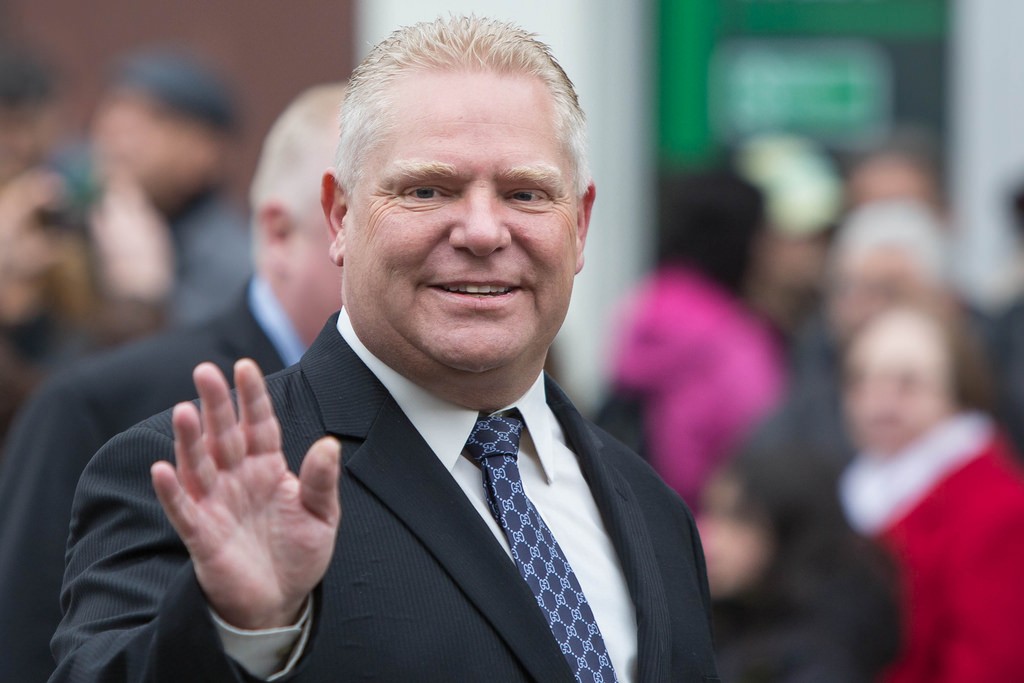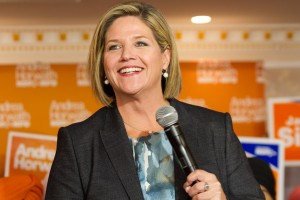The race is on: Ontario’s election campaign “is the PC’s to lose”
A long pre-campaign
Ontario’s provincial election campaign begins Wednesday, but it already feels like it’s been in full swing for two months. Provincial elections in Ontario used to be one of the most mundane events in Canadian politics, but a few things have changed that. 10 years ago, the province started having a fixed, four-year election cycle. That’s intensified the perpetual campaigning and fundraising by political parties.

Progressive Conservative party leader Doug Ford. Given the deep unpopularity of the ruling Liberals, the election is his party’s to lose. Photo: Bruce Reeve, Creative Commons, some rights reserved
The 2018 election campaign has already been more exciting because the governing Liberals under Premier Kathleen Wynne are deeply unpopular. The party has been in power since 2003 when Wynne’s predecessor, Dalton McGuinty, became Premier. In January, former Progressive Conservative (PC) leader Patrick Brown resigned amid accusations of sexual harassment and other ethics violations. A whirlwind leadership race followed and Doug Ford, the brother of late Toronto Mayor Rob Ford became leader on March 10.
The third major party in Ontario are the left-leaning New Democratic Party (NDP). Their leader, Andrea Horwath is running for Premier for a third time.
Plans and promises

Liberal Ontario Premier Kathleen Wynne. Her party has been in power in the province since 2003. Photo: Australian Minister for Trade Andrew Robb, Creative Commons, some rights reserved
Even after the tumultuous Patrick Brown affair and the ascendancy of Doug Ford, opinion polls still show the election is the PC’s to lose. But, the Liberals keep trying to provoke Ford to say or do something stupid to weaken his popularity.
Kathleen Wynne recently said that Doug Ford has the same personality and behavior of Donald Trump. Ford carefully dodged the accusation and said his focus is on Ontario, not the U.S. A few days ago, video footage was published of Ford saying he would relax development restrictions on the Greenbelt zone around the Toronto area that protects farmland and natural areas. Wynne and Horwath were immediately critical, and Ford quickly reversed his idea and said a PC government would leave the Greenbelt alone. That’s the closest Ford has so far gotten to damaging himself.
The Ontario Liberals are so far using their own 2018 government budget plan as their campaign platform. It contains all kinds of plans that would only happen if the government is re-elected. Those include public prescription drug insurance for everyone 65 and over, free post-secondary tuition for 225,000 more students, and free childcare for ages two to four, and billions for hospital improvements.
The Liberals chose to spend big and run a deficit, claiming that citizens want the government to do more instead of spending less. The original deficit prediction was $6.7 billion for 2018, but a recent report by the non-partisan Financial Accountability Office said it will actually be $12 billion because of the extra spending.

Ontario NDP leader Andrea Horwath. Photo: EK Park, Creative Commons, some rights reserved
The NDP is proposing similarly bold spending, including complete public prescription drug insurance, dental insurance, and publicly funded childcare for everyone. Their platform looks the most comprehensive; it also includes the environment and indigenous issues. It also contains a thorough explanation of how the NDP would pay for all its promises. In good social democratic fashion, that means shifting more taxation onto those with higher incomes.
Meanwhile, the PC’s are promising that anyone earning minimum wage in Ontario won’t pay any income tax. They’re also planning a full, public audit of government finances during the Liberal years because they’re convinced more malfeasance is hidden in the books. It’s all part of Doug Ford’s pledge to “respect the taxpayer.”
Ford has also told members of the “Hydro One Millionaires Club” to resign or he’ll fire them if he becomes Premier. The salaries of the executives of the large electrical utility are a convenient target of blame for Ontario’s high power rates, but it is only one reason for the problem. Rates are high because of over 20 years of policies that made them that way, and many of those policies were implemented under a previous PC government. The Wynne Liberals have also privatized Hydro One, making it doubtful that Doug Ford would have the power to fire its executives. And, Ontario is served by dozens of other private and municipally-owned utilities that have customer rates that are just as high. The NDP wants to re-nationalize Hydro One.
Eastern Ontario
In eastern Ontario, election results have developed a predictable pattern over the years. Urban Ottawa is solidly Liberal. Suburban areas are a mix of PC and Liberal. Kingston is Liberal, too. Rural counties like Frontenac, Lanark, and Leeds and Grenville have been Progressive Conservative for over 50 years. The far eastern counties of Stormont, Dundas, and Glengarry, and Prescott and Russell are swing areas that go either to the PCs or Liberals. Eastern Ontario has never been NDP territory. The factors of unpopularity, personality, and policy in this Ontario election campaign could make it a little less mundane than in the past.







